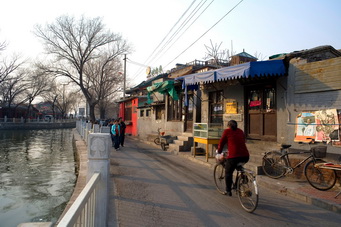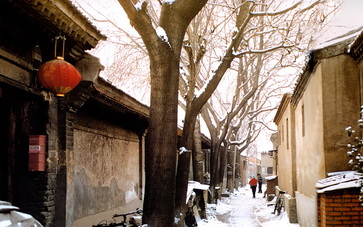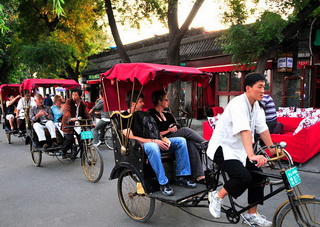 Hutong, the unique street design to Beijing, was created to reflect the imperial ruling of the emperors from within the Forbidden City. One of the explanations of Hutong has it that "Hu" is the name Han people called the other small Chinese tribes and "Tong" means "same" or "together", so Hutong means a harmony of living together between different ethnic tribes in China.
Hutong, the unique street design to Beijing, was created to reflect the imperial ruling of the emperors from within the Forbidden City. One of the explanations of Hutong has it that "Hu" is the name Han people called the other small Chinese tribes and "Tong" means "same" or "together", so Hutong means a harmony of living together between different ethnic tribes in China. Hutongs are closely associated with individual four-sided courtyard in which people  live. Most Hutongs are running east west for the local dwellers to procure the sunlight. When first started, around 700 years ago, Hutongs were built with the courtyards to the east and the west of the Forbidden City to accommodate high-ranking officials and relatives of the emperors. Afterwards, more were added to the north and south for merchants and common people and these were of a lower standard with lower walls, less or no ornate wood, stone and brick works, and less space.
live. Most Hutongs are running east west for the local dwellers to procure the sunlight. When first started, around 700 years ago, Hutongs were built with the courtyards to the east and the west of the Forbidden City to accommodate high-ranking officials and relatives of the emperors. Afterwards, more were added to the north and south for merchants and common people and these were of a lower standard with lower walls, less or no ornate wood, stone and brick works, and less space.
 The Hutongs and courtyards were the connection between the royal family and the outside world. The names for different Hutong are fascinating too; one is called Stinking Leather Hutong (reason can be that some merchants were once processing leather and became quite famous), and another is called Doufu Chen Hutong (reason can be that merchants were once making Doufu or bean curd here and became well-known). It is not only a kind of architecture, but also serves as a window into Beijing folk life and the "encyclopedia of the history and culture of Beijing."
The Hutongs and courtyards were the connection between the royal family and the outside world. The names for different Hutong are fascinating too; one is called Stinking Leather Hutong (reason can be that some merchants were once processing leather and became quite famous), and another is called Doufu Chen Hutong (reason can be that merchants were once making Doufu or bean curd here and became well-known). It is not only a kind of architecture, but also serves as a window into Beijing folk life and the "encyclopedia of the history and culture of Beijing."

 China Tours
China Tours Tibet Tours
Tibet Tours China Theme Tours
China Theme Tours Off The Beaten Track
Off The Beaten Track Yangtze Cruises
Yangtze Cruises China Trip Planner
China Trip Planner Travel Agents
Travel Agents China Tours
China Tours Tibet Tours
Tibet Tours China Theme Tours
China Theme Tours Off The Beaten Track
Off The Beaten Track Yangtze Cruises
Yangtze Cruises China Trip Planner
China Trip Planner Travel Agents
Travel Agents


 0086-28-85711328
0086-28-85711328 0086-28-85546015
0086-28-85546015




 Hutong, the unique street design to Beijing, was created to reflect the imperial ruling of the emperors from within the Forbidden City. One of the explanations of Hutong has it that "Hu" is the name Han people called the other small Chinese tribes and "Tong" means "same" or "together", so Hutong means a harmony of living together between different ethnic tribes in China.
Hutong, the unique street design to Beijing, was created to reflect the imperial ruling of the emperors from within the Forbidden City. One of the explanations of Hutong has it that "Hu" is the name Han people called the other small Chinese tribes and "Tong" means "same" or "together", so Hutong means a harmony of living together between different ethnic tribes in China.  live. Most Hutongs are running east west for the local dwellers to procure the sunlight. When first started, around 700 years ago, Hutongs were built with the courtyards to the east and the west of the Forbidden City to accommodate high-ranking officials and relatives of the emperors. Afterwards, more were added to the north and south for merchants and common people and these were of a lower standard with lower walls, less or no ornate wood, stone and brick works, and less space.
live. Most Hutongs are running east west for the local dwellers to procure the sunlight. When first started, around 700 years ago, Hutongs were built with the courtyards to the east and the west of the Forbidden City to accommodate high-ranking officials and relatives of the emperors. Afterwards, more were added to the north and south for merchants and common people and these were of a lower standard with lower walls, less or no ornate wood, stone and brick works, and less space.  The Hutongs and courtyards were the connection between the royal family and the outside world. The names for different Hutong are fascinating too; one is called Stinking Leather Hutong (reason can be that some merchants were once processing leather and became quite famous), and another is called Doufu Chen Hutong (reason can be that merchants were once making Doufu or bean curd here and became well-known). It is not only a kind of architecture, but also serves as a window into Beijing folk life and the "encyclopedia of the history and culture of Beijing."
The Hutongs and courtyards were the connection between the royal family and the outside world. The names for different Hutong are fascinating too; one is called Stinking Leather Hutong (reason can be that some merchants were once processing leather and became quite famous), and another is called Doufu Chen Hutong (reason can be that merchants were once making Doufu or bean curd here and became well-known). It is not only a kind of architecture, but also serves as a window into Beijing folk life and the "encyclopedia of the history and culture of Beijing."